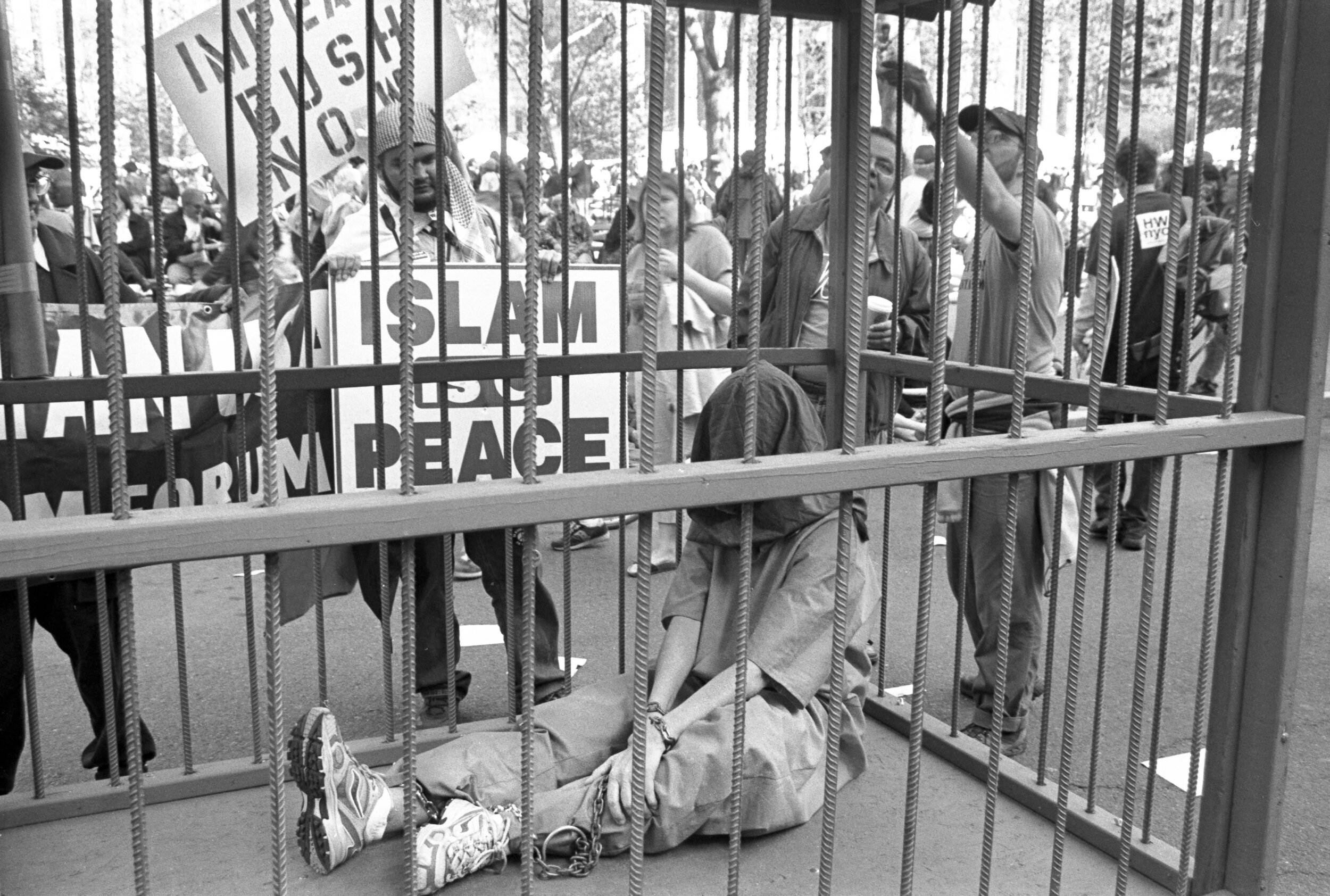The Bush Era Anti-War Movement
2003-2008
-text below gallery-
The Bush Era Anti-War Movement
February 2017
Since the initial military invasions of Afghanistan in October of 2001 and Iraq in March of 2003, the most overt foreign ramifications of the United States’ “Global War on Terror”, there has been a generation who have been born and have come of age without ever knowing a time without our military presence in these countries. No matter one’s political affiliations, it would have been disillusioning for all Americans to know that the United States would be still be militarily involved in both countries this many years later and still with no coherent plan for exit. Though the scale of military deployment is a fraction of what it was in the height of both of these conflicts and the ‘formal’ withdrawal from Iraq having taken place in 2012, the fallout of these invasions are ever present.
During the early years of the George W. Bush era anti-war movement, opposition to these wars and the way in which they were being conducted, despite the size of demonstrations, were not opinions that were particularly widely held by most Americans. A population grieving with the tragedy of 9/11 and experiencing the trauma that followed, fittingly wanted justice, even vengeance for what had taken place. This public sentiment essentially gave the Bush administration carte blanche for their military actions (as well as heavy-handed domestic policies, like the USA Patriot Act, which undermined American constitutional rights for an increased ability to surveil and detain ‘suspected’ terrorists).
In the decade plus that followed, with all that has become exposed, (e.g. the horrifying government sanctioned detainee torture program, fatalities resulting from tens of thousands of US soldiers being deployed into combat without proper body armor supplied or the non-existence of purported “weapons of mass destruction”) and all the harrowing events that have taken place (e.g. the sacking of Iraq’s National Library, the US bombing of a civilian wedding in Afghanistan or the bloody sectarian Iraqi Civil War) public and political support for these wars have all but vanished. Politicians, Republican and Democrat alike, who once were vehement supporters, over the years increasingly distanced themselves from these wars or would campaign on the understanding that these wars had become detrimental or in the case of Iraq, a mistake that was the result of, debatably deliberate, misinformation.
These wars are estimated to have heartbreakingly resulted in the deaths of nearly half a million people, including thousands of US military deaths, with tens of thousands of US military causalities and civilian deaths in the invaded countries in the hundreds of thousands. The running cost of these wars, while the US grapples to fund its most vital domestic responsibilities, is estimated to be over $5 trillion dollars. Among the disastrous missteps in strategy in the war in Iraq, maybe the most prominent was the inadvertent incubation of the Islamic State (ISIL), directly under the immediate watch of our anti-terrorist occupation. Despite the near two decades of military intervention in Afghanistan, not only does the Taliban still command a violent shadow government in portions of the country, in a region where Al-Qaeda is also still active, but the country in that time has become the world’s single largest exporter of opium for the international heroine market; while the US soared into an opioid epidemic in that same time. The results of these wars have in many cases been the opposite of their initial stated goals of bringing freedom, security and eliminating extremism in this part of the world.
Maybe the most prominent change in public attitude towards these wars since the initial invasions in the early 2000’s, is the lack of consideration for them at all. Between attention-burnout after the ongoing years of following these wars, deprioritized reporting and the excess of domestic issues that have evolved in that time, it is not difficult to understand why. The American population directly impacted by foreign military operations is relatively low compared to the total population (less than 0.5% of the US populations is active military personnel), leaving most citizens’ only regular reminders of these deployments are when our soldiers are honored at sporting events; while still commonly overlooking the reason those honorary displays became so prevalent just a decade and a half earlier.
The hardships faced by many of our returned veterans are a disgrace to our nation. Unlike the wars themselves, the public’s show of support for our soldiers has been unwavering over the years. This very much includes the anti-war movement, with many organizers having been veterans of these wars themselves. Despite this, veterans are unacceptably overrepresented in homeless populations and have suffered from tragically high suicide rates. How is this allowed to persist in a country where our taxes fund a defense budget larger than the next ten countries combined and has a population that holds such outward love and admiration towards the troops?
Looking back at these protest photos, some of them from immediately before the earliest days of the war in Iraq, it is difficult not become enraged at the militaristic course our country has taken to our present. For all of the anti-American slander that was directed at the anti-war movement, especially in the early years of the Bush administration, it is clear that the people who took to the streets were nothing but patriotic in their words and actions. The United States is not inherently good or evil; it is what we make of it, what we permit in the actions and policies done in our name. Collectively ignoring or excusing the disastrous result of our government’s foreign policies is elective stupidity and dooming us to never learn from our actions.
Photographs made in New York, NY, New Brunswick, NJ & Santa Monica, CA
Robert Farley, "50,000 started war without body armor," POLITIFACT, 2/4/2008, https://www.politifact.com/factchecks/2008/feb/04/hillary-clinton/50000-started-war-without-body-armor/
Patrick Martin, "The sacking of Iraq's museums: US wages war against culture and history," WSWS, 4/16/03, https://www.wsws.org/en/articles/2003/04/muse-a16.html
"Civilian catastrophe as US bombs Afghan wedding," The Guardian, 1/7/02, https://www.theguardian.com/world/2002/jul/01/afghanistan
Brian Cloughley, "Failure in Iraq and Afghanistan," Counterpunch, 4/8/14, https://www.counterpunch.org/2014/04/08/failure-in-iraq-and-afghanistan/
Mona Chalabi, "What Percentage of Americans Have Served in the Military?" FiveThirtyEight, 3/19/15, https://fivethirtyeight.com/features/what-percentage-of-americans-have-served-in-the-military/
Leo Shane III, "Report: War in Iraq, Afghanistan cost almost $5 trillion so far," Military Times, 9/12/16, https://www.militarytimes.com/news/your-military/2016/09/12/report-wars-in-iraq-afghanistan-cost-almost-5-trillion-so-far/
Martin Chulov, "Isis: the inside story," The Guardian, 12/11/14, https://www.theguardian.com/world/2014/dec/11/-sp-isis-the-inside-story
Alfred W. McCoy, "How opium defeated America in Afghanistan," Salon, 2/23/16, https://www.salon.com/2016/02/23/washingtons_21st_century_opium_wars_partner/
Maryia Statkevich, "Remembering America's Veterans in 2015," CAP, 11/11/15, https://www.americanprogress.org/article/remembering-americas-veterans-in-2015/
Nan Tian et al. "Trends World Military Expenditure, 2016," SIPRI, 4/2017, https://www.sipri.org/sites/default/files/Trends-world-military-expenditure-2016.pdf




















